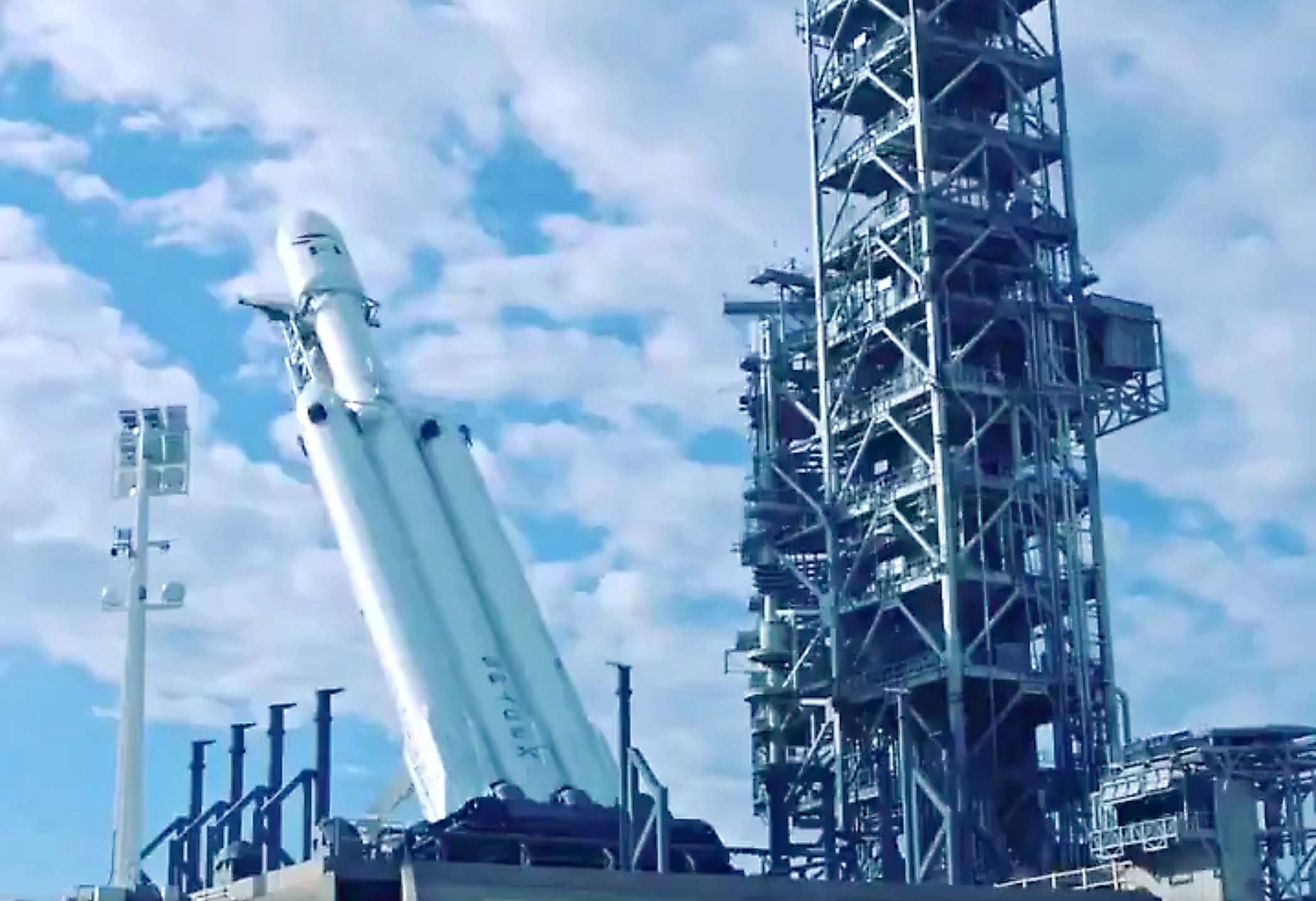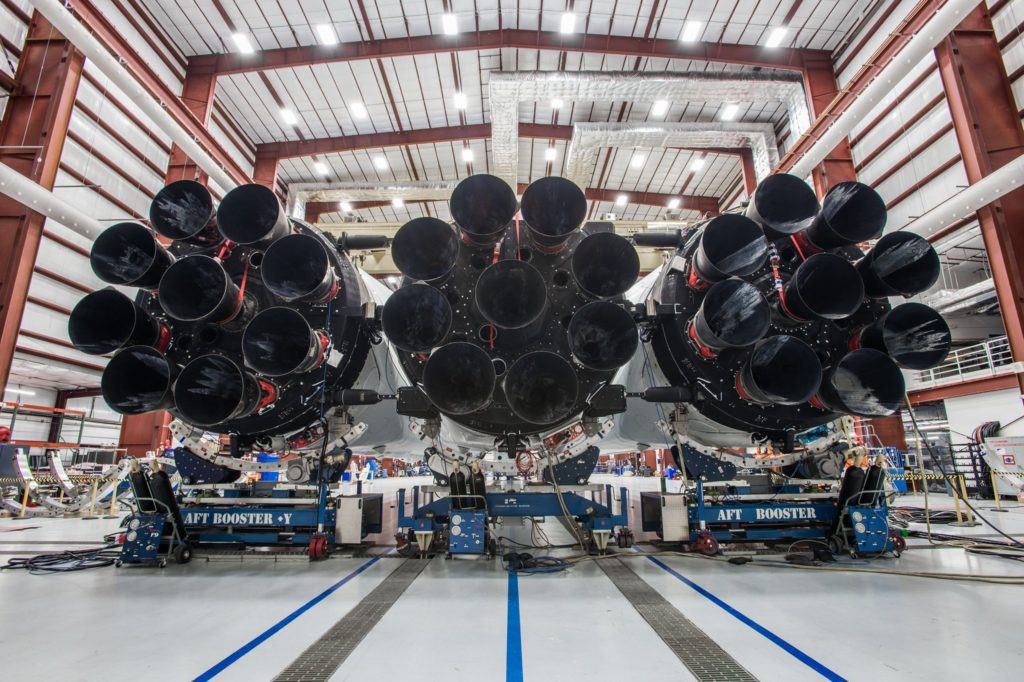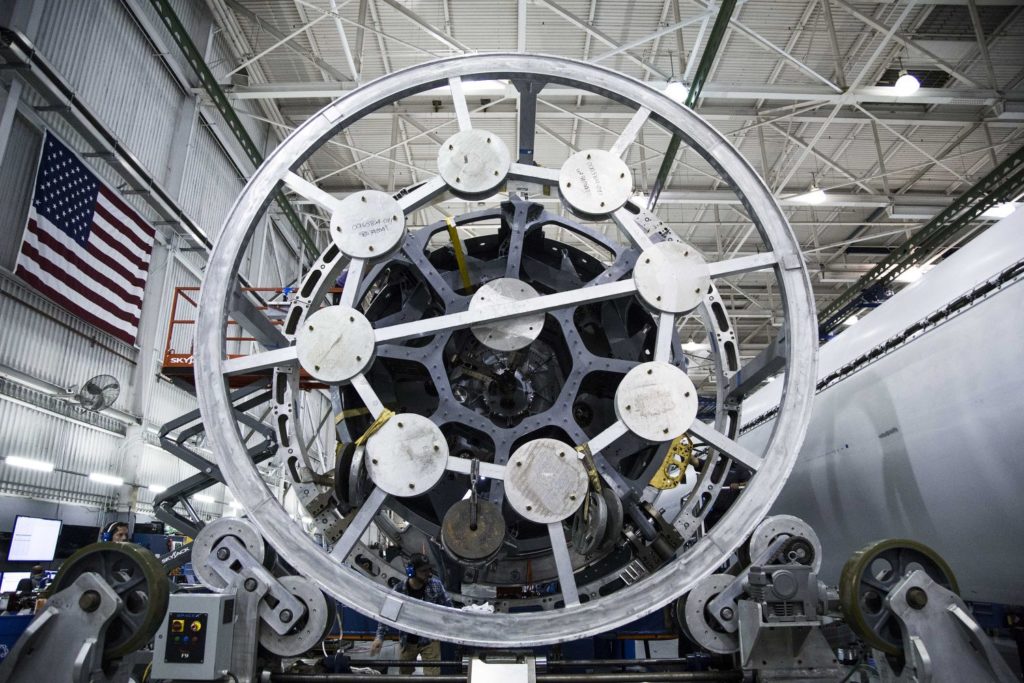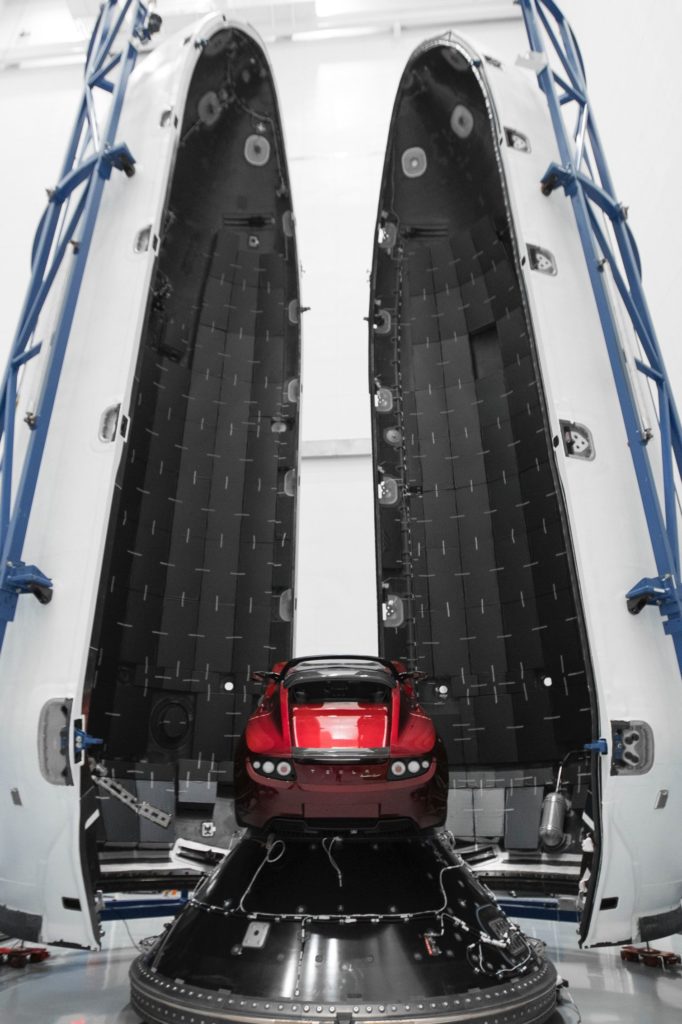

News
Musk shares timelapse of SpaceX Falcon Heavy being raised for launch prep
Elon Musk reiterated SpaceX’s commitment to completing the inaugural launch of Falcon Heavy before the end of January 2018 in a series of Instagram and Twitter posts. Delays with the companies commercial launch of the secretive Zuma payload will likely push Heavy back a similar number of days, but SpaceX still has a solid four weeks until February to prepare the vehicle and complete its more pressing commercial queue of launches.
Up next for Falcon Heavy will be the massive rocket’s first-ever integrated static fire, which will see all 27 of its Merlin 1D engines ignite for a brief several seconds in order to test a number of procedures and validate models of the rocket’s design and operations. Most importantly, in order to counteract the immense and potentially destructive torque produced by the simultaneous startup of 27 rocket engines, the first static fire will test a staggered ignition of all first stage engines, so as to spread out the force exerted upon the vehicle’s octawebs and booster connections. Musk’ Jan. 4 Instagram post points towards a static fire “next week,” sometime between January 8-15. The launch of Zuma is clearly the company’s main priority, at the moment.
https://www.instagram.com/p/BdjBHqdAIzs/?taken-by=elonmusk
- Falcon Heavy’s three boosters and 27 Merlin 1D engines on full display. (SpaceX)
- Falcon 9’s octaweb is shown exposed here in all its hunk-of-raw-metal glory. Falcon Heavy’s center octaweb is even beefier. (SpaceX)
- Elon Musk’s Roadster seen before being encapsulated in Falcon Heavy’s massive payload fairing. Below the Tesla is the payload adapter, which connects it to the rocket. (SpaceX)
Preceding this static fire, SpaceX will necessarily conduct a wet dress rehearsal (WDR) in which Falcon Heavy’s three first stages and single second stage will be fully loaded with supercooled high-grade kerosene (known as RP-1) and liquid oxygen. If this procedure fails to produce any unwanted surprises or insurmountable bugs, it’s probable that the WDR flow will transfer smoothly into static fire procedures. If bugs are found, the vehicle may instead be detanked of its propellant load and rolled back to LC-39A’s integration facilities in order to analyze those issues and ensure vehicle safety and readiness. Similar analysis will undoubtedly occur after the first static fire to verify that Falcon Heavy is still flight-worthy and its Tesla Roadster payload is in good condition.
After several barrages of thorough tests, the launch pad and vehicle will be ready for Falcon Heavy’s inaugural launch, no earlier than late January 2018. In the meantime, antsy fans can bask in the beauty of a timelapse Elon Musk recently posted, showing Falcon Heavy being lifted into a vertical orientation during its first pad-fit checks several days ago.
Falcon Heavy goes vertical pic.twitter.com/uG1k0WISv1
— Elon Musk (@elonmusk) January 5, 2018
Meanwhile, SpaceX is still tracking towards the imminent launch of Zuma, a secretive satellite payload that will see Falcon 9 return to Landing Zone 1 at Cape Canaveral. The mission has been delayed 48 hours from its original NET, and is now tentatively aiming to launch no earlier than (NET) January 6, but as of just a few minutes ago, SpaceX officially confirmed that additional propellant loading tests had been conducted with Zuma’s Falcon 9 booster earlier today, pushing the launch to NET January 7th, 8pm EST.
Team at the Cape completed additional propellant loading tests today. Extreme weather slowed operations but Falcon 9 and the Zuma spacecraft are healthy and go for launch—now targeting January 7 from Pad 40 in Florida.
— SpaceX (@SpaceX) January 5, 2018
Follow along live as our launch photographer Tom Cross braves the Florida cold and launch delays in pursuit of glorious rocket pics over the next several days.
News
Tesla begins Robotaxi certification push in Arizona: report
Tesla seems serious about expanding its Robotaxi service to several states in the coming months.

Tesla has initiated discussions with Arizona transportation regulators to certify its driverless Robotaxi service in the state, as per a recent report from Bloomberg News. The move follows Tesla’s launch of its Robotaxi pilot program in Austin, Texas, as well as CEO Elon Musk’s recent comments about the service’s expansion in the Bay Area.
The Arizona Department of Transportation confirmed to Bloomberg that Tesla has reached out to begin the certification process for autonomous ride-sharing operations in the state. While details remain limited, the outreach suggests that Tesla is serious about expanding its driverless Robotaxi service to several territories in the coming months.
The Arizona development comes as Tesla prepares to expand its service area in Austin this weekend, as per CEO Elon Musk in a post on X. Musk also stated that Tesla is targeting the San Francisco Bay Area as its next major market, with a potential launch “in a month or two,” pending regulatory approvals.
Tesla first launched its autonomous ride-hailing program on June 22 in Austin with a small fleet of Model Y vehicles, accompanied by a Tesla employee in the passenger seat to monitor safety. While still classified as a test, Musk has said the program will expand to about 1,000 vehicles in the coming months. Tesla will later upgrade its Robotaxi fleet with the Cyercab, a two-seater that is designed without a steering wheel.
Sightings of Cybercab castings around the Giga Texas complex suggests that Tesla may be ramping the initial trial production of the self-driving two-seater. Tesla, for its part, has noted in the past that volume production of the Cybercab is expected to start sometime next year.
In California, Tesla has already applied for a transportation charter-party carrier permit from the state’s Public Utilities Commission. The company is reportedly taking a phased approach to operating in California, with the Robotaxi service starting with pre-arranged rides for employees in vehicles with safety drivers.
News
Tesla sets November 6 date for 2025 Annual Shareholder Meeting
The automaker announced the date on Thursday in a Form 8-K.

Tesla has scheduled its 2025 annual shareholder meeting for November 6, addressing investor concerns that the company was nearing a legal deadline to hold the event.
The automaker announced the date on Thursday in a Form 8-K submitted to the United States Securities and Exchange Commission (SEC). The company also listed a new proposal submission deadline of July 31 for items to be included in the proxy statement.
Tesla’s announcement followed calls from a group of 27 shareholders, including the leaders of large public pension funds, which urged Tesla’s board to formally set the meeting date, as noted in a report from The Wall Street Journal.
The group noted that under Texas law, where Tesla is now incorporated, companies must hold annual meetings within 13 months of the last one if requested by shareholders. Tesla’s previous annual shareholder meeting was held on June 13, 2024, which placed the July 13 deadline in focus.
Tesla originally stated in its 2024 annual report that it would file its proxy statement by the end of April. However, an amended filing on April 30 indicated that the Board of Directors had not yet finalized a meeting date, at least at the time.
The April filing also confirmed that Tesla’s board had formed a special committee to evaluate certain matters related to CEO Elon Musk’s compensation plan. Musk’s CEO performance award remains at the center of a lengthy legal dispute in Delaware, Tesla’s former state of incorporation.
Due to the aftermath of Musk’s legal dispute about his compensation plan in Delaware, he has not been paid for his work at Tesla for several years. Musk, for his part, has noted that he is more concerned about his voting stake in Tesla than his actual salary.
At last year’s annual meeting, TSLA shareholders voted to reapprove Elon Musk’s compensation plan and ratified Tesla’s decision to relocate its legal domicile from Delaware to Texas.
Elon Musk
Grok coming to Tesla vehicles next week “at the latest:” Elon Musk
Grok’s rollout to Tesla vehicles is expected to begin next week at the latest.

Elon Musk announced on Thursday that Grok, the large language model developed by his startup xAI, will soon be available in Tesla vehicles. Grok’s rollout to Tesla vehicles is expected to begin next week at the latest, further deepening the ties between the two Elon Musk-led companies.
Tesla–xAI synergy
Musk confirmed the news on X shortly after livestreaming the release of Grok 4, xAI’s latest large language model. “Grok is coming to Tesla vehicles very soon. Next week at the latest,” Musk wrote in a post on social media platform X.
During the livestream, Musk and several members of the xAI team highlighted several upgrades to Grok 4’s voice capabilities and performance metrics, positioning the LLM as competitive with top-tier models from OpenAI and Google.
The in-vehicle integration of Grok marks a new chapter in Tesla’s AI development. While Tesla has long relied on in-house systems for autonomous driving and energy optimization, Grok’s integration would introduce conversational AI directly into its vehicles’ user experience. This integration could potentially improve customer interaction inside Tesla vehicles.
xAI and Tesla’s collaborative footprint
Grok’s upcoming rollout to Tesla vehicles adds to a growing business relationship between Tesla and xAI. Earlier this year, Tesla disclosed that it generated $198.3 million in revenue from commercial, consulting, and support agreements with xAI, as noted in a report from Bloomberg News. A large portion of that amount, however, came from the sale of Megapack energy storage systems to the artificial intelligence startup.
In July 2023, Musk polled X users about whether Tesla should invest $5 billion in xAI. While no formal investment has been made so far, 68% of poll participants voted yes, and Musk has since stated that the idea would be discussed with Tesla’s board.
-

 Elon Musk1 week ago
Elon Musk1 week agoTesla investors will be shocked by Jim Cramer’s latest assessment
-

 Elon Musk3 days ago
Elon Musk3 days agoElon Musk confirms Grok 4 launch on July 9 with livestream event
-

 Elon Musk15 hours ago
Elon Musk15 hours agoxAI launches Grok 4 with new $300/month SuperGrok Heavy subscription
-

 News7 days ago
News7 days agoTesla Model 3 ranks as the safest new car in Europe for 2025, per Euro NCAP tests
-

 Elon Musk2 weeks ago
Elon Musk2 weeks agoA Tesla just delivered itself to a customer autonomously, Elon Musk confirms
-

 Elon Musk1 week ago
Elon Musk1 week agoxAI’s Memphis data center receives air permit despite community criticism
-

 Elon Musk2 weeks ago
Elon Musk2 weeks agoTesla’s Omead Afshar, known as Elon Musk’s right-hand man, leaves company: reports
-

 News2 weeks ago
News2 weeks agoXiaomi CEO congratulates Tesla on first FSD delivery: “We have to continue learning!”
















